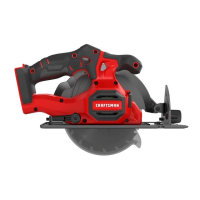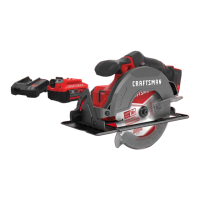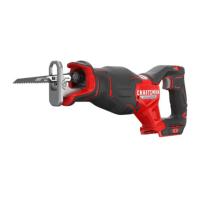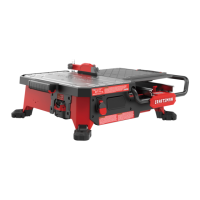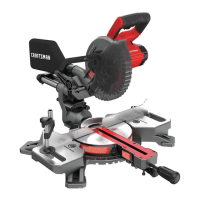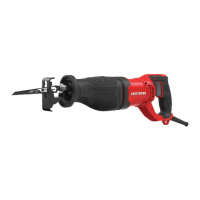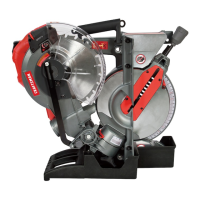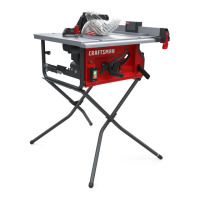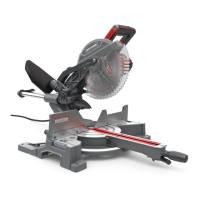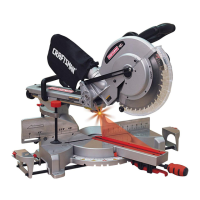ENGLISH
12
Shoe Adjustment for 90 ° Cuts (Fig. A, I)
The shoe
5
has been set by the factory to assure that the
blade is perpendicular to the shoe at 0° bevelsetting.
If realignment is needed:
1. Adjust the saw to 0°bevel.
2. Retract blade guard
7
.
3. Loosen bevel adjustment knob
10
. Place a square
against the blade
14
and shoe
5
to adjust the
90°setting.
4. Loosen the nut
24
and move the adjustment screw
23
so that the shoe will stop at the proper angle. Retighten
nut against the shoe while holding adjustment screw
inposition.
5. Confirm the accuracy of the setting by checking the
squareness of an actual cut on a scrap piece ofmaterial.
Bevel Angle Adjustment (Fig. A, H)
The full range of the bevel adjustment is from 0° to 50°. The
quadrant is graduated in increments of 1°. On the front of the
saw is a bevel angle adjustment mechanism consisting of a
calibrated quadrant and a bevel adjustment lever
10
.
To Set the Saw for a Bevel Cut
1. Loosen (counterclockwise) the bevel adjustment
lever
10
and tilt shoe (
5
, Fig.A) to the desired angle by
aligning the pointer with the desired anglemark.
2. Retighten lever firmly (clockwise).
Cutting Depth Adjustment (Fig. A, G)
1. Hold the saw firmly and loosen (counterclockwise) the
depth adjustment lever
4
and move shoe (
5
, Fig.A) to
obtain the desired depth ofcut.
2. Make sure the depth adjustment lever has been
retightened (clockwise) before operatingsaw.
For the most efficient cutting action, set the depth
adjustment so that one‑half tooth of the blade will project
below the material to be cut. This distance is from the tip of
the tooth to the bottom of the gullet in front of it. This keeps
blade friction at a minimum, removes sawdust from the cut,
results in cooler, faster sawing and reduces the chance of
kickback. A method for checking for correct cutting depth
is shown in FigureG. Lay a piece of the material you plan to
cut along the side of the blade, as shown, and observe how
much tooth projects beyond thematerial.
saw. Both blade angle to the shoe and greater blade
surface in the material increase the chance for binding
and misalignment (twist) tooccur.
7. RESTARTING A CUT WITH THE BLADE TEETH
JAMMED AGAINST THE MATERIAL
a. The saw should be brought up to full operating speed
before starting a cut or restarting a cut after the unit
has been stopped with the blade in the kerf. Failure to
do so can cause stalling andkickback.
Any other conditions which could result in pinching, binding,
twisting, or misalignment of the blade could cause kickback.
Refer to the sections Further Safety Instructions for All
Saws and Blades for procedures and techniques that will
minimize the occurrence ofkickback.
back toward the operator. If the blade becomes twisted or
misaligned in the cut, the teeth at the back edge of the blade
can dig into the top surface of the wood causing the blade to
climb out of the kerf and jump back toward theoperator.
Kickback is more likely to occur when any of the following
conditionsexists.
1. IMPROPER WORKPIECE SUPPORT
a. Sagging or improper lifting of the cut off piece can
cause pinching of the blade and lead tokickback.
b. Cutting through material supported at the outer ends
only can cause kickback. As the material weakens it
sags, closing down the kerf and pinching theblade.
c. Cutting off a cantilevered or overhanging piece of
material from the bottom up in a vertical direction
can cause kickback. The falling cut off piece can pinch
theblade.
d. Cutting off long narrow strips (as in ripping) can cause
kickback. The cut off strip can sag or twist closing the
kerf and pinching theblade.
e. Snagging the lower guard on a surface below the
material being cut momentarily reduces operator
control. The saw can lift partially out of the cut
increasing the chance of bladetwist.
2. IMPROPER DEPTH OF CUT SETTING ON SAW
a. To make the most efficient cut, the blade should
protrude only far enough to expose one‑half of a
tooth. This allows the shoe to support the blade and
minimizes twisting and pinching in the material. See
the section titled Cutting DepthAdjustment.
3. BLADE TWISTING (MISALIGNMENT IN CUT)
a. Pushing harder to cut through a knot, a nail or a hard
grain area can cause the blade totwist.
b. Trying to turn the saw in the cut (trying to get back on
the marked line) can cause bladetwist.
c. Overreaching or operating the saw with poor body
control (out of balance), can result in twisting
theblade.
d. Changing hand grip or body position while cutting
can result in bladetwist.
e. Backing up the saw to clear blade can lead totwist.
4. MATERIALS THAT REQUIRE EXTRA ATTENTION
a. Wet lumber
b. Green lumber (material freshly cut or not kiln dried)
c. Pressure treated lumber (material treated with
preservatives or anti‑rot chemicals)
5. USE OF DULL OR DIRTY BLADES
a. Dull blades cause increased loading of the saw. To
compensate, an operator will usually push harder
which further loads the unit and promotes twisting
of the blade in the kerf. Worn blades may also have
insufficient body clearance which increases the
chance of binding and increasedloading.
6. LIFTING THE SAW WHEN MAKING A BEVEL CUT
a. Bevel cuts require special operator attention to proper
cutting techniques – especially guidance of the

